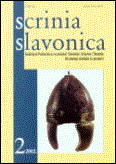RATARSTVO U SLAVONSKOJ POSAVINI KRAJEM 17. STOLJEĆA
ARABLE FARMING IN SLAVONIAN POSAVINAAT THE END OF THE 17TH CENTURY
Author(s): Milan VrbanusSubject(s): History
Published by: Hrvatski institut za povijest
Summary/Abstract: Slavonian Posavina is located on the left bank of the Sava River and on the southern foothills of Psunj and Dilj. Most of the cultivable land is located in the plain along the Sava, and was exposed to frequent flooding, which made the cultivation of almost half of the ploughland in the area impossible. In this area there were however good preconditions for the development of arable farming, more than two fifths of the ploughland being fertile and less than a tenth being infertile. This relates in particular to the district of Kobaš, where almost two thirds of the ploughland were fertile. Unfortunately, the frequent floods in this area prevented arable farming developing rapidly, although the population in the inundated areas put in great efforts while cultivating their fields, attempting to improve their economic condition. The population had very weak material foundations, however, for the development of farming.[...] . However, these households did also cultivate considerable areas, thus attempting to gain enough wealth to be able to purchase the oxen necessary for better tilling. And yet the requent floods in the area largely rendered their efforts nugatory. Slavonian Posavina had 2,999 jutro (approximately equivalent to an acre) of land under the plough, which was about one third of all cultivable land. In this area the percentage of cultivation was quite a lot higher than the average for the time in Slavonia. This relatively high percentage is the consequence of the very high percentage of cultivation in the district of Kobaš, where more than a half of all cultivable land was tilled. The population of this area tilled per household a bit less than 2.5 (2.47) jutro of land, lower than the average area in Slavonia in 1698 (3.14 jutro per household). The smallness of the average area of cultivated land was the result of the very small area of tilled ploughland per household in the district of Brod (1.55 jutro per household). The people in Slavonian Posavina cultivated wheat, barley and oats, but no millet or maize. Wheat was the most common crop in this area. This cereal took up more than six sevenths, and barley and oats together less than one seventh, of all the cultivated areas. Wheat and barley were more common in the plains of the area, oats in the hilly areas. Arable farming would have been stronger if an embankment had been built along the banks of the Sava. When an embankment was built, it would speed up the development of arable farming by preventing such frequent spillages of the river and the consequent destruction of the produce. By selling their surpluses, eventually the population accumulated the funds necessary to buy the oxen for the tilling of their land. Unfortunately, a great deal of time was to pass before this process was completed.
Journal: Scrinia Slavonica
- Issue Year: 2002
- Issue No: 2
- Page Range: 202-260
- Page Count: 59
- Language: Croatian

